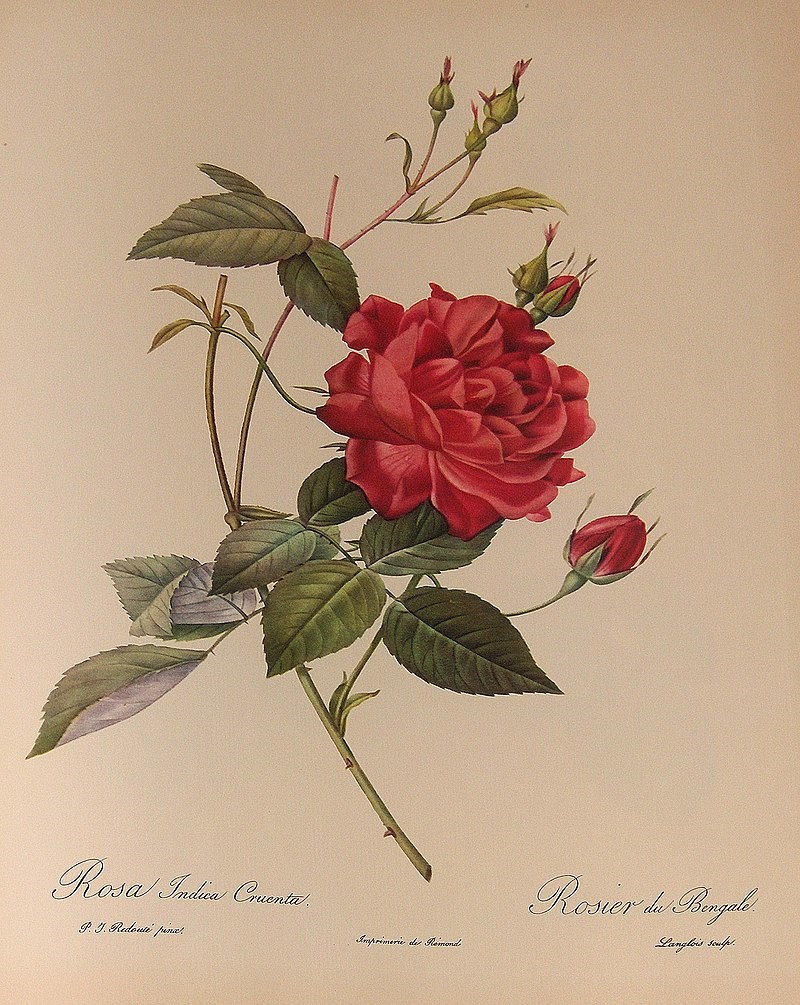
Photo by Aaron Fink
Written by Shawn McCourt, Ph.D.
When one thinks of flowers in southwest Florida, roses seldom come to mind, yet a handful of species, hybrids, and cultivars do thrive here. One noteworthy cultivar of the China rose (Rosa chinensis) called ‘Louis Philippe’ is an excellent, carefree rose for Florida’s humid subtropical climate. So much so, that it was widely planted in here in the 19th century and came to be so intertwined with the Anglo-American settlement of Florida that it earned the nickname of “Cracker rose” after the Florida Cracker culture it was associated with.
The ‘Louis Philippe’ rose was first introduced to the southeastern United States by the Yucatán-born Manuel Lorenzo Justiniano de Zavala y Sáenz, who was first Mexico’s minister to France, then governor of Mexico; and later still, Vice President of the newly-proclaimed Republic of Texas that he helped to create. It is believed the rose was a gift from the French to de Zavala during his ministry to France, and he and his second wife, the Connecticut-born Emily West, planted it at their home in Lynchburg, Texas near Houston.

Though native to southern China, Rosa chinensis was first brought to the West in the late 18th century by the British East India Company. Because Calcutta (modern Kolkata) in Bengal was a major port from which goods from the East were imported into Europe, the rose was believed to have originated there, and was initially named Rosa indica or the “Bengal rose” by Carl Linnaeus before Jacquin corrected it as Rosa chinensis in 1768. Until the China rose was introduced to Britain and France, all roses in Europe typically bloomed only once in a season, in the spring. Remontant China roses made repeat blooming possible, and as a result, they were given the Latin epithet ‘semperflorens’ or “ever-blooming” (Curtis 1794). They were seized upon by gardeners and horticulturists alike looking to improve European rose stocks. Such was the fate of a China rose cultivar called ‘Slater’s Crimson’ which was acquired from Britain for Empress Josephine’s garden at Malmaison and painted for her by Pierre Joseph Redouté in his Les Roses sometime between 1817 and 1821 (Figure 1). The French dominated rose breeding at the time, and ‘Slater’s Crimson’ became the founding stock for many modern rose varieties. Roses from Malmaison eventually made their way into the hands of Modesté Guerin, a renown gardener and rosarian, and these included ‘Slater’s Crimson’ which he used as a parent in the cross that produced ‘Louis Philippe’ in 1834, at his home in Angers, France. The new rose was named in honor of (and presented to) the Duke of Orléans, Louis Philippe I, who was the last king of the French during the short-lived “July monarchy” (1830-1848). From the greenhouses at Malmaison and Versailles, roses were among the plants given to dignitaries governing the colonies, even after the Bourbon Restoration. Repeat-blooming China roses and their progeny would have been as prized as the most expensive orchid today, and eagerly sought after by the elite. In this way, the rose was brought Texas by Lorenzo de Zavala and his wife Emily, who were avid gardeners. In fact, Emily West de Zavala is still remembered today in song as the fabled “Yellow Rose of Texas.” More than 100 years later, this beautiful gift from the court of King Louis Philippe had become a staple in the landscape of the American South as the “Zavala Rose” or the “Cracker Rose”.
The flowers of ‘Louis Philippe’ are loosely double, about 2″ across, and colored a deep rose red with a hint of lighter blush pink in the center. A white stripe through the petals is frequently observed, a trait which belies its China rose heritage. Though individual flowers do not last long, they are numerous, and ‘Louis Philippe’ repeats blooming on a regular and reliable cycle. The blooms are fragrant, with a classic old rose scent and the petals were often an ingredient in old southern recipes for rose syrups, rose-flavored waters, jellies, candies and other recipes. They also dry quickly and keep their color, making them a vibrant, scented choice for potpourri.
‘Louis Philippe’ is one of the easiest roses to grow, and with very little effort, even in our torrid summers. This rose is winter hardy in Zones 7 to 11, where it grows to be 3-6 feet tall or more, with a bushy to climbing habit. It is a long-lived plant and can still frequently be found growing wild around neglected homes and gardens in the South. A heritage rose garden simply cannot be complete without one, and Mabel Ringling’s famous rose garden at the Ringling Museum has several. Plant it in well-drained soil in full sun. All roses need at least 5 hours of full sun each day to bloom well, and here in southwest Florida, an eastern to southeastern exposure is best, but anywhere it can escape the sun during hottest part of the day works fine. The beautiful matte-green leaves of ‘Louis Philippe’ are very disease resistant, and unlike with many roses, pesticides are never needed. Black spot, the fungal bane of most roses in the South, seldom occurs in ‘Louis Philippe’ and when it does, diseased leaves generally shed off and are quickly replaced by healthy ones. When planting, supplemental irrigation is needed until the plant is well established, after which ‘Louis Philippe’ will be drought tolerant. Roses always bloom on new growth, so deadheading the spent blooms is recommended, as it encourages branching and new blooms. The shrub should also be pruned to shape when young and then pruned to shape and maintain desired size when mature once or twice annually.
Come see our ‘Louis Philippe’ roses now blooming on the west side of the Christy Payne Mansion carriage house and in pots on the south-facing patio of the Selby House at our downtown campus.
